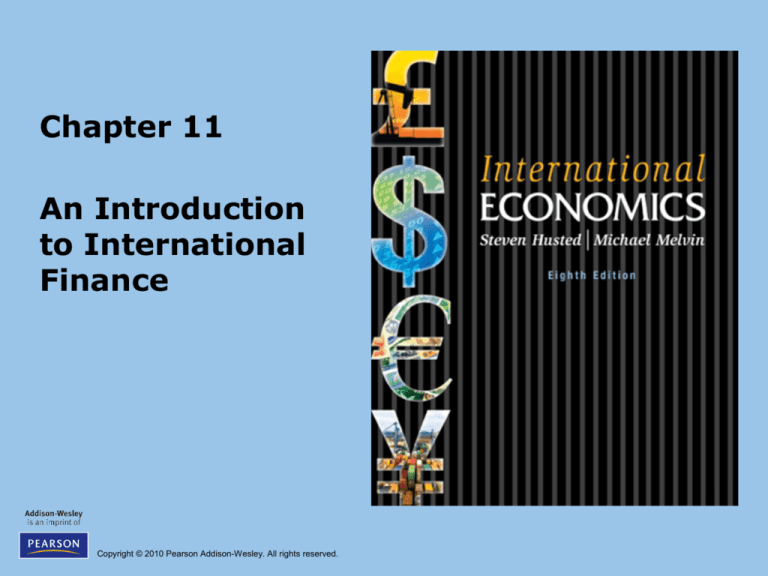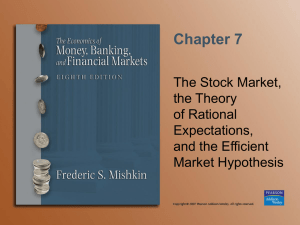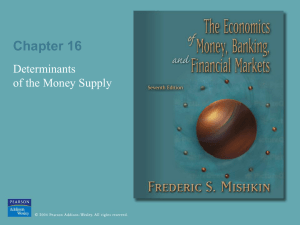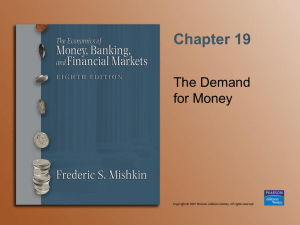
Chapter 11
An Introduction
to International
Finance
Copyright © 2010 Pearson Addison-Wesley. All rights reserved.
Topics to be Covered
•
•
•
•
•
Foreign accounts-Balance of payments
Exchange rates-exchange rate markets
Prices and exchange rates
Interest and exchange rates
Other topics
– International portfolios
– Economic activity and prices in an open
economy
– Exchange rate systems, crises
– International debt, crises
Copyright © 2010 Pearson Addison-Wesley. All rights reserved.
11-2
Balance of Payments (BOP)
• BOP—a record of a country’s economic
transactions with the rest of the world.
Copyright © 2010 Pearson Addison-Wesley. All rights reserved.
11-3
Trade Surplus vs. Trade
Deficit
• Trade surplus—occurs when a country’s
merchandise exports exceed its imports.
• Trade deficit—occurs when a country’s
merchandise imports exceed its exports.
• The U.S. has consistently experienced trade
deficits, with 1975 as the last surplus year,
while Japan, Germany, and Switzerland have
had trade surpluses (refer to Figure 11.1).
Copyright © 2010 Pearson Addison-Wesley. All rights reserved.
11-4
FIGURE 11.1 The Trade Balance
over Time
Copyright © 2010 Pearson Addison-Wesley. All rights reserved.
11-5
Trade Balance & Services
Balance, Switzerland
Copyright © 2010 Pearson Addison-Wesley. All rights reserved.
11-6
Exchange Rates
Exchange rate—price of one country’s
money in terms of another
• Foreign Exchange Market (FEM)—
the market where monies of different
countries are traded.
Copyright © 2010 Pearson Addison-Wesley. All rights reserved.
11-7
Features of Foreign Exchange
Market
• Refer to Table 11.1 FEM Trading Volume
• The total volume of trade in the foreign
exchange market was approximately $4
trillion in 2007.
• The largest markets are the U.K., accounting
for 34% of the world market, and the U.S.
with a 17% share.
Copyright © 2010 Pearson Addison-Wesley. All rights reserved.
11-8
TABLE 11.1 Foreign Exchange
Market Trading Volume
Copyright © 2010 Pearson Addison-Wesley. All rights reserved.
11-9
Features of FEM (cont.)
• Refer to Table 11.2
• The most traded currency is the U.S. dollar,
accounting for 86% of the total amount
traded.
• The dollar is followed by the euro, the
Japanese yen, and the British pound.
Copyright © 2010 Pearson Addison-Wesley. All rights reserved.
11-10
TABLE 11.2 Use of Currencies on One Side
of the Transaction as a Percentage of Total
Foreign-Exchange Market Volume
Copyright © 2010 Pearson Addison-Wesley. All rights reserved.
11-11
Prices and Exchange Rates
• Purchasing Power Parity (PPP) holds when
two currencies have the same purchasing
power in the two countries.
• Chapter 14 will analyze the prices–exchange
rate relationship in more detail.
Copyright © 2010 Pearson Addison-Wesley. All rights reserved.
11-12
Copyright © 2010 Pearson Addison-Wesley. All rights reserved.
11-13
Big Mac PPP
• Refer to Table 11.3 Big Mac PPP
• If the price of a Big Mac hamburger were $1 in the
U.S. and CHF 1 in CH and the CHF/$ exchange rate
were 1 then Big Mac PPP would hold.
• In Table 11.3, PPP would hold if a Big Mac in
Switzerland was 1.02 CHF. But it cost much more
than this! PPP does not hold.
• PPP appears to hold more for Australia.
• China’s yuan is undervalued by 50% against the
dollar; thus dollars will buy more in China. The
reverse is true for Switzerland.
Copyright © 2010 Pearson Addison-Wesley. All rights reserved.
11-14
TABLE 11.3 Big Mac Purchasing
Power Parity
Copyright © 2010 Pearson Addison-Wesley. All rights reserved.
11-15
Interest Rates and Exchange
Rates
• Figure 11.2 shows that even countries with
close and extensive economic ties can have
independent movements in their interest
rates.
• Interest differentials among countries may
reflect expected exchange rate changes as
well as risk premiums.
• Chapter 15 will discuss interest rates in more
detail.
Copyright © 2010 Pearson Addison-Wesley. All rights reserved.
11-16
FIGURE 11.2 Interest Rates Across
Countries
Copyright © 2010 Pearson Addison-Wesley. All rights reserved.
11-17
Interest rates
Copyright © 2010 Pearson Addison-Wesley. All rights reserved.
11-18
Additional Major Topics to be
Covered Later
• Foreign exchange risk—the risk of an
unexpected change in the exchange rate.
• International investment—portfolio
investment and direct investment.
• International monetary systems
(exchange rate systems)
Properties and history of international
monetary systems. Currency crises.
Copyright © 2010 Pearson Addison-Wesley. All rights reserved.
11-19
Additional Topics (cont.)
• International macroeconomics—
determination of equilibrium income, interest
rates, and exchange rates in an open
economy.
• International debt. Debt crises.
Copyright © 2010 Pearson Addison-Wesley. All rights reserved.
11-20








